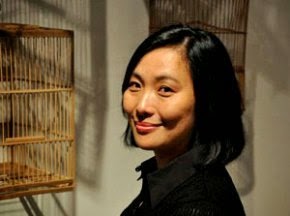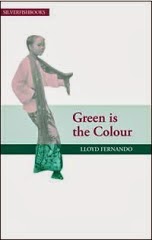Prodigious playwright/director/actor Huzir Sulaiman
Okay, there were THREE members of the audience who made a major
show of not enjoying one of the finest satires I’ve seen staged anywhere.
Someone whispered that they were from City Hall, there to monitor the
performance for offensive, subversive, or pornographic content. After the
recent fiasco over its ill-advised attempt to ban the Instant Café Theatre from
the city of KL (thanks, Mr Mayor, for speaking out on behalf of good sense and
reversing the ban; I insert a round of applause for that silver lining on an
inquisitorial dark cloud), it’s understandable that City Hall would be feeling
defensive.
Keeping sewers clean, streets swept, and petty traders on their
toes isn’t quite as glamorous or exciting as intimidating the fancy-talking
faggoty arty-farty fringe. However, what one person labels “offensive” another
calls “hilariously honest.” You have to really hate how you look to object so
strenuously to your own reflection. Art’s primary function is to reflect our
lives. Everyone ought to know that. Certain artistic approaches may work more
like distorting mirrors but being able to laugh at your own comical aspects
means your ego is healthy and comfortable with itself.
Claire
Wong as Mary Yuen,
Huzir Sulaiman as General Zulkifli
Huzir Sulaiman as General Zulkifli
All true art is subversive, reclaiming for the individual the
power the State constantly attempts to steal. Everyone knows that if art is
subservient rather than subversive, most likely it’s mere corporate propaganda.
And in response to the question of what constitutes “pornography,” all I can
say is: “Honi soit qui mal y pense.” Evil to whomsoever thinks evil.
Enough! We won’t allow City Hall to steal the show, no matter
how badly it wants in on the limelight. I want this to pass as a review, not
just a rave. So how did I like Atomic Jaya’s new
incarnation?
Enormously! The original version was more or less a 14-character
monodrama: a litmus test of any actor’s ability, agility and nerve, sort of
like tightrope-crossing Niagara Falls on a unicycle. This Checkpoint Theatre
production features Claire Wong and Huzir Sulaiman on a breezy tandem ride
through Bolehland – with crisp digital images meticulously crafted by director
Casey Lim and flashed on a paper screen as a kinetic backdrop (the
state-of-the-art, high-resolution Panasonic projector produced startlingly
clear images). It also has Fahmi Fadzil playing a double rôle as a
canteen makcik and patriotic singer.
While the original version was supercharged with manic intensity
and a stark, dark surrealism, this new production heightens and broadens the
comedy, thus increasing its entertainment value without detracting from the
script’s satirical incisiveness. And in any case it’s doubly pleasurable to
watch two consummate performers tackle the main characters instead of one.
What gives Atomic Jaya a
solid core of substance beyond the guffaws, sniggers and belly laughs is the
play’s underlying seriousness as anthropological commentary. The fact that it
opened in Kuala Lumpur on August 6th – on the 58th anniversary of Hiroshima,
when 80,000 human lives were destroyed by an atomic bomb dropped by the United
States Air Force, followed by another over Nagasaki three days later which
decimated horrific thousands more – was a grim reminder to us all that we’re
still living under a nuclear sword of Damocles (not “umbrella” as some may
pretend).
The mind-boggling insanity of squandering trillions on an ongoing
program of Mutual Assured Destruction – instead of redirecting every available
resource towards the alleviation of suffering caused by simple lack – has its
roots in the malignant human ego when it takes on exaggerated nationalistic
proportions. Can the laser surgery of sharp-tongued humor excise the tumor of
ruinous pride and megalomaniacal ambition.
Explosive
performance
Perhaps not, but weapons-grade satire produces a chain reaction
of transcendental consciousness among those it infects with despair-banishing
mirth. And even the deadliest strain of militant pomposity cannot withstand
well-aimed ridicule, though it will try its damnedest to outlaw and suppress
it.
On the strength of the three or four plays (and one short
film, That Historical Feeling by the prolific Huzir
Sulaiman) in which I’ve seen Claire Wong act, I’d place her amongst the top
ranks in both hemispheres. The precision, sensitivity and vitality she infuses
into each rôle makes her – like Jo Kukathas, who created the original
characterizations – an extraordinary shapeshifter.
Who can forget her Dr Saiful from UKM (“Oh, you are discussing
philosophy. Very interesting. For example, ‘Men are from Besut, Women are from
Dungun.’ I also like philosophy.”)? Or her thumb-twiddling malapropic minister
(“Why should we import the highly enriched Iranian? We already buy the Persian
carpet and the Persian cat from the Iranian so they become highly enriched at
our expense.”)?
Claire
Wong, consummate shapeshifter
In two seconds flat she visibly gained 200 pounds as former US
Secretary of State Madeleine Albright: “We have the might, and we have the
right, and we will not hesitate to fight for the right to our might, and our
might alone. Ask not what your country can do for you; rather, ask what our
country can do to your country.”
But as nuclear physicist Dr Mary Yuen, Claire Wong was 100% the
real McCoy. No problem passing her off as a Chinese Catholic girl from Ipoh who
just happened to idolize Lord Rutherford, Niels Bohr, Erwin Schrödinger, Max
Planck, Albert Einstein, and the entire subatomic pantheon.
Huzir Sulaiman was in top comic form as General Zulkifli (with
his classic Napoleon Complex and unforgettable lines like, “I want to get to
the bottom of this matter. Until the bottom is reached, the top cannot be
happy.”); and the excitable Delhi Polytechnic graduate, Dr Ramachandran (“If
you vant to take yumbrage, make sure this taking of yumbrage is correct and
prahper. Yumbrage simply cannot be taken at vhim or vhimsy. You vill vaste the
yumbrage.”)
He had a spot of trouble getting an exact fix on the extremely
sleazy Mr Bala, and his Otto (the low-grade European) could have been further
fine-tuned; but he outdid himself as a whole stream of newsreaders from the
BBC, CNN and RTM – and as a police officer addressing a group of protestors
(all 7 of them) with a loudhailer: “This is an illegal assembly. I order you to
disperse. This is your first warning. Tangkap mereka semua.” An immortal
characterization in only four lines.
Noraini, the canteen operator at Syarikat Perniagaan Atomic Jaya
Sdn Bhd, was played in drag by Fahmi Fadzil who turned in a laudably restrained
performance. Fahmi also did a superb job as a nattily besongkoked patriotic song-rendering robot, as instant
palm trees waved in the electronically generated background.
Director Casey Lim’s wizardry with digital design is matched by
a fine intuition for injecting just the right symbolism with almost subliminal
subtlety. The choice of a solitary hibiscus flower (Malaysia’s national emblem)
as central motif was an inspired one. Closeups of the stamen evoked understated
phallic imagery and mimicked the mushroom cloud that would later dominate the
entire backdrop with chilling effect. From nationalistic egocentricity to
testosteronal displays of potency – just by changing camera angles on a
hibiscus flower – pretty neat!
When all the elements of a play work together so efficiently (and with
such apparent effortlessness) to produce an aesthetically satisfying synergetic
gestalt, we are reminded that Creation is infinitely wise and perpetually
self-perfecting. So what if the country or even the whole goddamn planet is
temporarily in the hands of Sharkey and his perception-challenged
henchmen? The vision quest only makes sense and carries any value if it
bears the ring of truth – and Huzir Sulaiman’s Atomic
Jaya rings true for me. Go see it if you haven’t. And even if
you have, go see it again.
sources :http://blogcritics.org/theathre













